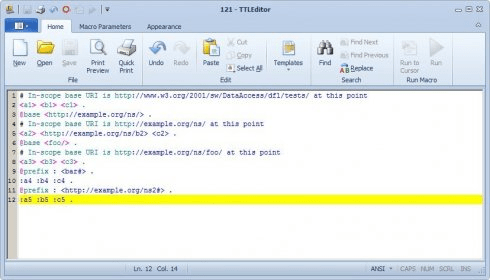
Tera Term Macro Examples
I am using a Tera Term over a serial port to do some testing on a board. Recently I found out I can do some scripting in Tera Term so I have been doing research to help automate and make testing a little easier. I know Tera Term has a site that lists example macros as well as a command list but I guess what I need is someone with experience scripting in Tera Term. Tera Term uses a sort of Basic language called Tera Term Language (TTL) but I found it hard from the site to actually identify which commands I needed to use. Tera term site. OK, I did some digging and found a moderately active forum: It is there that I found a nice thread called: TeraTerm Macro Language for dummies.
Daily thanthi epaper pdf download. That, and the command list on the actual TeraTerm project site is where I have been troubleshooting and solving 90% of my issues. To take in a user defined input you use the 'inputbox' command, which follows the format: inputbox 'message' 'title' [default] (not entirely sure what default is supposed to be doing) E.G.
LogMeTT Tutorial 1. What is LogMeTT? LogMeTT is a launcher application for TeraTerm -terminal emulator- macro. A user can automate login procedure to. Apr 28, 2018 - Tera Term Serial Macro Example. Tera Term command line Tera Term command line TTERMPRO [ [[:]] telnet://[:][/] pipe ] [/B] [/BAUD=] [/C=].
Inputbox 'Please type input' 'Input' a dialog box will appear and prompt a response. This input is sent to a default variable inputstr I have gotten this variable to work in some cases but I think the problem is that the variable is technically a string type so I can't do traditional loops. I need to figure out a way to use the str2int command to do an expression. I think that answers my own immediate question as well as provide some reference for others.
What is subroutine.ttl? Tera Term Macro has limited support for writing reusable code. It is possible to include a file but it is not possible to use a goto or call command to easily jump to a specific block of code in a file. Subroutine.ttl emulates a function call syntax and allows you to write more modular, compartmentalized code. For example, given two files (main.ttl and util.ttl), you could write something like this in main.ttl: callsub = 'util:clear_system_logs' include 'subroutine.ttl' This will call the clear_system_logs subroutine in util.ttl::clear_system_logs; Put your code here!
Return subroutine.ttl requires Tera Term version 4.66 or higher. It is licensed under the terms of.
See LICENSE.txt for the full text of the license. How do I use it? You will need to copy subroutine.ttl into your source code directory and copy the following code to the top of each of your modular.ttl files:; Confirm that ``__include_goto_label`` is defined and is a string. Didakticheskuyu igru podberi domik 2. Ifdefined __include_goto_label if result == 3 then; Confirm that ``__include_goto_label`` is not an empty string. Strlen __include_goto_label if result then; Confirm that ``__include_goto_label`` is an actual label. Sprintf2 __execstr 'ifdefined%s' __include_goto_label execcmnd __execstr if result == 4 then; The label exists.
Call the subroutine and return. Sprintf2 __execstr 'call%s' __include_goto_label execcmnd __execstr result = 0 exit endif result = GOTO_LABEL_NOT_DEFINED exit endif endif; This is the default subroutine to call. Change the name if desired.